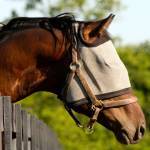Equine Comfort: Bloodsucking Stable Flies Might Soon Meet Their Match

Depending on the season, Mother Nature often makes horsekeeping a joyless pursuit. Think about it: snow and ice in winter, rain and mud in spring and, perhaps most frustrating of all, flies in the spring, summer, and fall. (And maybe in the winter, depending on location!) Among the throng of flying pests, stable flies rank high as nuisances to horses.
As blood feeders, stable flies land on their targets and feed for only a few minutes before they take flight in search of a resting place to digest their meal. Most horses tolerate stable flies reasonably well, but some find them especially annoying, leading horses to stomp aggressively, walk fencelines, or even gallop off to scatter a swarm and evade painful bites. Depending on the population of stable flies and the degree of stress they cause, soundness issues, allergic reactions, and weight loss can occur.
Reducing the population of stable flies often depends on a multipronged approach: thoughtful manure management, including thorough stall cleaning; screening of barn openings; careful positioning of high-powered fans to create a downward and outward airflow; insecticides; and fly traps and sticky paper.*
The use of sticky paper and adhesive traps is nothing new in the fight against stable flies. Infusing those same lures with specially formulated attractants called semiochemicals, however, reveals an innovative approach. Semiochemicals, or signal chemicals, are organic compounds used by insects to convey specific messages that change behavior; pheromones are well-known semiochemicals.
Researchers stationed at the Agroecosystem Management Research Unit, a Nebraska facility maintained by the Agricultural Research Service-United States Department of Agriculture, recently tested the effectiveness of adhesive traps impregnated with a proprietary blend of semiochemicals. While this research was carried out on a cattle feedlot, horse owners may soon benefit from the work.**
The attractant-imbued adhesive traps performed well in the trial, decreasing the fly population and reducing biting-fly avoidance behavior in cattle. From a practical perspective, the new traps are less expensive and more user-friendly than traditional traps that use attractants.
“Most horse owners understand the importance of fly control. A summertime drive through the countryside, especially in my area, reveals horses outfitted in fly masks, fly boots, and even throat-to-tail fly sheets with UV protection,” said Catherine Whitehouse, M.S., a nutritionist at Kentucky Equine Research. “Diehard traditionalists may snicker at this protective wear, but many horses are far more comfortable with it than without it. If it keeps horses from running from flies, and potentially losing weight, then I am all for its use.”
When stable flies are especially numerous, horses may make their way to run-in sheds or other shady areas and in the process forego grazing. This can be problematic if horses are stalled for a portion of the day and fed little when confined, according to Whitehouse. “Observe horses to determine when they like to graze based on weather and insect activity, and then choose a turnout time compatible with that. During fly season, owners often choose nighttime turnout.”
“As a nutritionist, I am sometimes asked about feed-through insecticides. The active ingredients in these supplements—larvicides—are passed out with the manure, making the manure toxic to developing fly larvae,” explained Whitehouse. “Research and anecdotal evidence suggests these products are effective but with a couple of caveats: every horse on the property must be administered the product and stable flies will still lay eggs in wet areas inside and outside of the barn. Barn hygiene remains a critical factor in fly control.”
While wet muck, including spilled grain and discarded hay, inside the barn can be the ideal environment for larval development, do not disregard outside areas. Manure piles are obviously problematic, but one more obscure source of trouble might be the wasted hay around round bales or round-bale feeders that accumulates and mixes with manure.
*Townsend, L. 2007. Fly control around horse barns and stables. Cooperative Extension Service, University of Kentucky, College of Agriculture. ENTFACT-514.
**Zhu, J.J., G.-H. Roh, Y. Asamoto, K. Bizati, J.-C. Liu, A. Lehmann, K. Harrison, D.B. Taylor, and H. Otake. 2021. Development and first evaluation of an attractant impregnated adhesive tape against blood-sucking flies. Insect Science. https://doi.org/10.1111/1744-7917.12952








